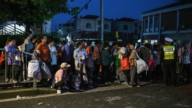【新唐人2014年05月31日讯】中国是世界上儿童自杀率最高的国家,出于学习压力自杀的儿童比例高达近50%。尤其近年来,大陆中小学生自杀已经成为一个越来越严重的社会现象,甚至民间将每年的三到六月称为“学生自杀黑暗季”。眼看一年一度的大陆中、高考又将来临,接二连三的学生自杀事件再现各地校园。
据大陆媒体报导,近期浙江温州市发生一起离奇的高中生投河事件。5月23号凌晨2点,温州市平阳中学高三学生小峰(化名),从学校监控录像显示,他离开了宿舍,随后失踪。30个小时后,他的尸体在学校附近的一条河里被发现,经法医鉴定为溺水身亡。
小峰失踪后,同学在他的课桌上发现一张纸条,上面写着:“我抛弃了我的肉体。放弃了我的灵魂……”后面还附有一串神秘的数字(9 1 13 9 14 23 1 20 5 18)。
据小峰的同桌说,出事前,小峰曾告诉他,用数字对应英文字母是最基本的密码破译方法。而这串数字对应的英文字母是“I am in water”,汉语意思是“我在水里”。种种迹象表明,小峰是死于自杀。
小峰为什么会投河自尽?他的老师、同学、邻居都无法解释。但小峰选择在高考前自杀,让舆论很难不将他的死因与大陆备受诟病的高考制度联系到一起。
“21世纪教育研究院”在5月13号发布的2014年教育蓝皮书中,收录了去年79例中小学生自杀案例研究报告。研究发现,学生自杀根本的原因在于高度应试的教育制度。
大陆文化评论家叶匡政:“因为中国目前中小学的教材是7、80年代来确定的,那个时候的方针就是以科技来兴国,当时有这样一个政策。所以导致现在中小学的整个数、理、化都是非常难的。比如讲,中国大陆初中生的数学水平,有人做过比较,就相当于美国高中生的这种数学水平,包括物理、化学都是学的很多复杂的知识。其实这些知识呢,除了未来从事科技工作以外,大部分人其实是用不上的,这就导致学生的负担越来越重。”
那么,在巨大的学习压力下“挺”过来的学生们,是否能实现了他们“前程似锦”的梦想呢?据中科院对30年来1,000多位“高考状元”的跟踪调查显示,这些昔日备受瞩目、令人惊羡的“高考状元”们,没有一个成为国家精英级的人物或行业领军人物。其中有七成在毕业后便销声匿迹。
畸形教育制度下的“高考状元”们尚且如此,普通大学生的处境就更加艰难。据官方数据显示,2013年中国高校毕业生已达699万,被称为“史上最难就业年”。而2014年的毕业生人数将达到727万人,成为“更难就业年”。
但值得关注的是,并不是“人才过剩”造成的供大于求导致了中国大学生的就业难。据大陆就业中介机构调查显示,超过7成的企业为找不到实用的人才而苦恼。而造成这种“人才荒”与“就业难”现象并存的根本原因,就是大陆高校的教育与现实严重脱节,培养出了一批又一批“纸上谈兵的秀才”。
叶匡政:“大陆的这种教育方式和西方有很大的不同。它一方面只重视技术教育,就是将知识视为工具,然后用知识的灌输来取代对知识的理解,包括创新。其实中国现代教育的一个核心的问题就是:它的本质就是要把人教育成工具。另一方面就是它忽视人格教育,包括人文教育。它这种教育中,更多的是强调你对知识的记忆,但是它很少的让你去发展,就是培养你的思维能力,或者思考力,更多的是强化对权力的服从和接受。”
更为严重的是,除了逐年递增的未成年人因为学习压力而自杀外,近年来,越来越多的“高学历人才”毕业后,因为找不到工作而抑郁自杀的事件也开始在中国大陆频繁上演。
采访编辑/张天宇 后制/李勇
Middle School Student Commits Suicide
China has the world’s highest youth suicide rate.
Nearly 50% of the youth suicide occurred for
heavy school loads.
School children suicides have become
a serious social phenomenon.
In China, between March and June it is considered the
‘dark suicide season’.
With annual entrance examinations approaching,
youth suicides are seen at schools throughout China.
A Wenzhou City high school student was reportedly to have
committed suicide by jumping into the river.
According to the school surveillance video, Wenzhou City High
School student Xiao Feng (pseudonym) had been missing since
he left the dorm at 2 AM on May 23.
His body was found in a nearby river 30 hours later.
Forensics confirmed he died of drowning.
His schoolmate found a note on his desk that read:
I abandoned my body. I gave up my soul …
This was followed by a series of mysterious numbers:
9, 1, 13, 9, 14, 23, 1, 20, 5, 18.
A classmate said that Xiao Feng had said the most basic
code-breaking finds the corresponding letter of the alphabet.
According to the method, the corresponding letters are
I, A, M, I, N, W, A, T, E, R.
That means, I am in water.
It suggests that Xiao Feng died of committing suicide.
Why would Xiao Feng commit suicide?
None of the teachers, classmates or neighbors could explain.
However, his decision came right before the entrance exam,
it is natural to connect his act to the much criticized
entrance exam in China.
In the 2014 Education Blue Book published by the 21st
Century Education Research Institute, 79 cases of middle
school student suicides were analyzed.
The research found that the intensive exams of the education
system were the fundamental reason for the suicides.
Ye Kuangzheng, mainland cultural critic: The current
textbooks were materials determined during the 1970s and
1980s when technology was the state policy to develop China.
It has caused the entire middle school math, physics and
chemistry to be on the difficult side.
Take middle school math as an example.
It is as difficult as high school math in the United States.
The physics and the chemistry are also very complex.
In fact, this knowledge is useless to majority of the people
other than to those who engage in technology.
However, they increase the burden on the students.
So, what happened to those who made it through
the tough pressure of study?
Have they achieved their dreams?
According to a survey by the Chinese Academy of Sciences
out of more than 1,000 top students having passed the college
entrance exam over the past 30 years, none of them became
the so-called national elite or leaders of industry.
About 70% of them have disappeared after graduation.
Comparing to those top students, the situation is even tougher
for other students.
Official data showed more than 6.99 million college graduates
in 2013 had the toughest year to find a job in history.
There will be 7.27 million graduates in 2014, it is anticipated
to be even harder than the 2013.
However, the employment difficulty was not caused by
oversupply of talents.
According to the mainland employment agency’s survey,
more than 70% of employers complain that it is hard
to find practical talents.
It is the serious gap between the college education and
industry needs that has created batches of college graduates
with a diploma but without any real capabilities, and thus
the phenomenon of “lack of talents" and “lack of jobs".
Ye Kuangzheng: Mainland China’s education is
very different from the West.
In mainland, techniques are the focus.
Knowledge is just a tool.
They instill the knowledge, but ignore the understanding of
the knowledge and innovation.
The modern education problem in China is to train people
to become tools.
It also lacks education on personality and humanities.
They focus more on memorization, rather than the
development and cultivation of logic thinking.
There are more demands on obedience and acceptance to power.
In addition to the increasing annual suicide rates among
the youths over school work pressure, recently, more and more
Chinese college graduates also took suicide as the final
resort over depression of not being able to find a job.
Interview & Edit/Zhang Tianyu Post-Production/Li Yong






























